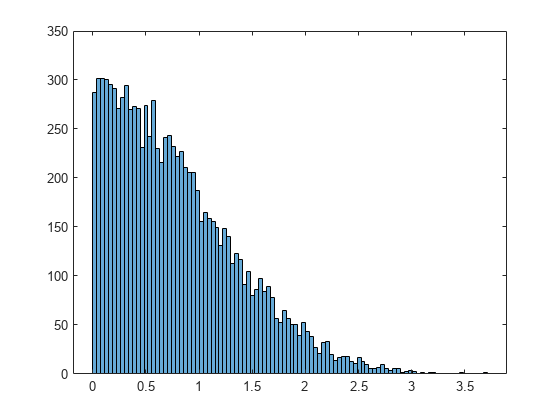truncate
对概率分布对象进行截尾
说明
示例
创建一个标准正态概率分布对象。
pd = makedist('Normal')pd =
NormalDistribution
Normal distribution
mu = 0
sigma = 1
将分布截尾为具有下限 -2 和上限 2。
t = truncate(pd,-2,2)
t =
NormalDistribution
Normal distribution
mu = 0
sigma = 1
Truncated to the interval [-2, 2]
绘制原始分布和截尾分布的 pdf 以进行视觉比较。
x = linspace(-3,3,1000); figure plot(x,pdf(pd,x)) hold on plot(x,pdf(t,x),'LineStyle','--') legend('Normal','Truncated') hold off

创建一个标准正态概率分布对象。
pd = makedist('Normal')pd =
NormalDistribution
Normal distribution
mu = 0
sigma = 1
通过将分布限制为正值来对分布进行截尾。将下限设置为 0,上限设置为无穷大。
t = truncate(pd,0,inf)
t =
NormalDistribution
Normal distribution
mu = 0
sigma = 1
Truncated to the interval [0, Inf]
从截尾分布生成随机数并用直方图可视化。
r = random(t,10000,1); histogram(r,100)

输入参数
概率分布,指定为下表中的概率分布对象之一。
截尾下限,指定为标量值。
数据类型: single | double
截尾上限,指定为标量值。
数据类型: single | double
输出参量
扩展功能
用法说明和限制:
输入参量
pd可以是 beta、指数、极值、对数正态、正态和威布尔分布的拟合概率分布对象。通过对来自fitdist函数的样本数据进行概率分布拟合,创建pd。有关示例,请参阅Code Generation for Probability Distribution Objects。截尾概率分布对象不能为入口函数的输入参量。要使用对象函数(如
cdf、pdf、mean等)计算截尾分布,请在单个入口函数中调用truncate和一个或多个上述对象函数。
有关代码生成的详细信息,请参阅 Introduction to Code Generation 和 General Code Generation Workflow。
此函数完全支持 GPU 数组。有关详细信息,请参阅在 GPU 上运行 MATLAB 函数 (Parallel Computing Toolbox)。
版本历史记录
在 R2013a 中推出
MATLAB Command
You clicked a link that corresponds to this MATLAB command:
Run the command by entering it in the MATLAB Command Window. Web browsers do not support MATLAB commands.
选择网站
选择网站以获取翻译的可用内容,以及查看当地活动和优惠。根据您的位置,我们建议您选择:。
您也可以从以下列表中选择网站:
如何获得最佳网站性能
选择中国网站(中文或英文)以获得最佳网站性能。其他 MathWorks 国家/地区网站并未针对您所在位置的访问进行优化。
美洲
- América Latina (Español)
- Canada (English)
- United States (English)
欧洲
- Belgium (English)
- Denmark (English)
- Deutschland (Deutsch)
- España (Español)
- Finland (English)
- France (Français)
- Ireland (English)
- Italia (Italiano)
- Luxembourg (English)
- Netherlands (English)
- Norway (English)
- Österreich (Deutsch)
- Portugal (English)
- Sweden (English)
- Switzerland
- United Kingdom (English)